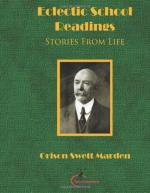Poor Watt! He had traveled with bleeding feet along the same thorny path trod by the great inventors and benefactors of all ages. But, in spite of all obstacles, he persevered; and, after ten years of inconceivable labor and hardship, during which his beautiful wife died, he had a glorious triumph. His perfected steam engine was the wonder of the age. Sir James Mackintosh placed him “at the head of all inventors in all ages and nations.” “I look upon him,” said the poet Wordsworth, “considering both the magnitude and the universality of his genius, as, perhaps, the most extraordinary man that this country ever produced.”
Wealthy beyond his desires,—for he cared not for wealth,—crowned with the laurel wreath of fame, honored by the civilized world as one of its greatest benefactors, the struggle over, the triumph achieved, on August 19, 1819, he lay down to rest.
HOW THE ART OF PRINTING WAS DISCOVERED
“Look, Grandfather; see what the letters have done!” exclaimed a delighted boy, as he picked up the piece of parchment in which Grandfather Coster had carried the bark letters cut from the trees in the grove, for the instruction and amusement of his little grandsons.
“See what the letters have done!” echoed the old man. “Bless me, what does the child mean?” and his eyes twinkled with pleasure, as he noted the astonishment and pleasure visible on the little face. “Let me see what it is that pleases thee so, Laurence,” and he eagerly took the parchment from the boy’s hand.
“Bless my soul!” cried the old man, after gazing spellbound upon it for some seconds. The track of the mysterious footprint in the sand excited no more surprise in the mind of Robinson Crusoe than Grandfather Coster felt at the sight which met his eyes. There, distinctly impressed upon the parchment, was a clear imprint of the bark letters; though, of course, they were reversed or turned about.
But you twentieth-century young folks who have your fill of story books, picture books, and reading matter of all kinds, are wondering, perhaps, what all this talk about bark letters and parchment and imprint of letters means.
To understand it, you must carry your imagination away back more than five centuries—quite a long journey of the mind, even for “grown-ups”—to a time when there were no printed books, and when very, very few of the rich and noble, and scarcely any of the so-called common people, could read. In those far-off days there were no public libraries, and no books except rare and expensive volumes, written by hand, mainly by monks in their quiet monasteries, on parchment or vellum.
In the quaint, drowsy, picturesque town of Haarlem, in Holland, with its narrow, irregular, grass-grown streets and many-gabled houses, the projecting upper stories of which almost meet, one particular house, which seems even older than any of the others, is pointed out to visitors as one of the most interesting sights of the ancient place. It was in this house that Laurence Coster, the father of the art of printing, the man—at least so runs the legend—who made it possible for the poorest and humblest to enjoy the inestimable luxury of books and reading, lived and loved and dreamed more than five hundred years ago.




